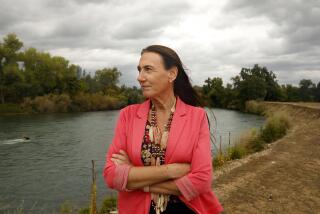Bone Hints at Donner Party Cannibalism
- Share via
Archeologists have found what may be a human bone scarred by the marks of a butcher’s ax, possibly the first physical evidence that the 1846 Donner Party -- trapped in the Sierra Nevada by early blizzards -- resorted to cannibalism.
If the bone is confirmed to be human, “that would really be the smoking gun,” proving that the travelers ultimately were forced to eat some of their companions to survive the harsh winter, said archeology team leader Julie Schablitsky.
The team made the discovery at Alder Creek on the outskirts of Truckee. Although parts of the site have been excavated before, the team found evidence of a hearth and other artifacts that may be the strongest evidence yet that the Donner Party made its winter camp there.
Although many descendants of Donner Party members view it as the camp, some historians say the actual site was on a part of Alder Creek now submerged by the nearby Prosser Creek Reservoir, and thus lost to history.
“We’re really thrilled about the discovery and hope this will trigger some funding so they can do more research,” said Frankye Craig, an amateur historian in Reno. “Everyone is hoping that they will turn up a diary or a buried box or something like that with items of interest to the Donner Party. There was no one left to carry that stuff out.”
The story of the Donner Party has gripped the imagination like few other tales of westward migration. George and Jacob Donner and James Frazier Reed gathered up their families in the spring of 1846 and left Illinois for the golden promise of California.
On July 20, their group -- 20 wagons and 81 people -- made a fateful decision, departing from the well-known and frequently traveled wagon trail to take a “shortcut” that promised to trim several hundred miles from their trip.
But the new route was harder than they expected, dissension was rife and progress was slow. Ultimately, they were halted by a blizzard just short of what is now called Donner Pass and forced to erect a winter camp. They soon ate all their food and animals, and hunting and fishing were virtually nonexistent. As people died, their flesh was reportedly cut off and eaten. Two Miwoc Indians assisting the group were purportedly killed and eaten as well.
By the time rescuers from Sutter’s Fort reached the party, half the Donner group had died.
“It’s a very human story,” Craig said. “They were people like you and me, just trying to survive. And the survivors were so traumatized by the stigmatism and shame [of the cannibalism] that they wouldn’t speak of it, not even to their children.”
Many aspects of their struggle to survive are not completely clear.
The group settled into two encampments, one at the well-known site on the shore of what is now Donner Lake and the second four to five miles away on Alder Creek, where the Donners themselves waited out the weather. The actual site of the second -- so-called lower -- camp has been the subject of dispute for some time.
Archeologist Donald Hardesty of the University of Nevada, Reno, excavated part of the Alder Creek site in 1990 and 1993. His team found artifacts, small bone fragments and other objects that seemed to support the idea that this was the lower camp, “but we did not find an intact feature, like a foundation from a shelter or a fire hearth that you could definitely associate with the encampment,” he said. They also found no human remains, either at Alder Creek or Donner Lake.
Working near where Hardesty had dug, Schablitsky and her colleague Kelly Dixon of the University of Montana discovered a hearth -- fire-glazed rocks, charcoal fragments, burned bones and other objects. “That in itself is quite significant,” Hardesty said, because it indicates the presence of a campsite of the right age.
They also found a ceramic pipe bowl fragment, a buckle from a leather belt, lead shot from firearms and glass from a hurricane lamp. Perhaps most important, they found “a small brass link from a delicate chain, like a woman’s necklace,” Schablitsky said. That indicates “a female presence in the camp,” which would not be the case if the camp had belonged to later miners or hunters.
In addition, the team discovered a section of a mammalian bone, possibly human, with ax marks on it, suggesting butchering. The team has sent it to a lab for analysis. If it is human, they will try to match the DNA with that of Donner descendants, who have agreed to cooperate.
“We approach an archeological site like a crime scene, using tools such as forensic testing,” Schablitsky said. “Now we need to find out if the bones are human and possibly who they are related to.”
She said the team was at the site only four days and was able to open up only four 1-square-yard holes. She is convinced that there is much more to be found.
The team was supported by the Discovery Channel, and the research will appear on television in October as part of the “Unsolved History” series.
More to Read
Sign up for Essential California
The most important California stories and recommendations in your inbox every morning.
You may occasionally receive promotional content from the Los Angeles Times.










